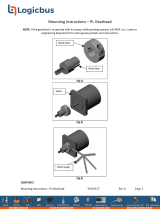
−3−
1 Entry
1 Introduction ................................................................ 8
1.1 Before using the product ...................................................8
1.2 Related operating manuals ...............................................8
2 Safety precautions ..................................................... 9
3 Precautions for use .................................................. 11
4 System conguration .............................................. 13
5 Preparation ................................................................ 14
5.1 Checking the product ...................................................... 14
5.2 Information about nameplate .......................................15
5.3 Lists of combinations ........................................................16
5.4 Names and functions of parts ....................................... 18
2 Installation and connection
1 Installation ................................................................ 22
1.1 Installation location...........................................................22
1.2 Installing the combination type-parallel shaft
gearhead ............................................................................... 22
1.3 Installing the combination type-hollow shaft at
gearhead ............................................................................... 24
1.4 Installing the round shaft type ...................................... 27
1.5 Installing a load for combination type-parallel
shaft gearhead, round shaft type ................................. 28
1.6 Installation of load for combination type-hollow
shaft at gearhead ............................................................. 29
1.7 Permissible radial load and permissible axial
load ......................................................................................... 31
1.8 Installing the driver ........................................................... 32
1.9 Installing the external potentiometer
(sold separately) .................................................................34
1.10 Installing the regeneration resistor
(sold separately) .................................................................34
2 Connection ................................................................ 35
2.1 Connection example ........................................................ 35
2.2 Connecting the power supply .......................................36
2.3 Grounding ............................................................................37
2.4 Connecting the motor and driver ................................ 38
2.5 Selecting a power supply for input signals............... 38
2.6 Connecting the I/O signals ............................................. 39
2.7 Connecting analog external setting devices ........... 43
2.8 Connecting the data setter ............................................43
2.9 Connecting the regeneration resistor ........................ 44
2.10 Connection diagram (example) .................................... 45
2.11 Noise elimination measures ........................................... 48
3 Connection method for each control mode ....... 49
3.1 Switching of control mode .............................................49
3.2 Assignment of I/O signals for each control mode ...50
Speed control mode (factory setting).................................50
Position control mode ..............................................................50
BX-compatible mode (speed control) ................................50
BX-compatible mode (position control) ............................ 51
3.3 Connection diagram for each control mode............51
4 Explanation of I/O signals ....................................... 55
4.1 Overview of I/O signals .................................................... 55
Input signals list .......................................................................... 55
Internal input circuit ..................................................................55
Changing the logic level setting of input signals ...........55
Timing chart when power is input ....................................... 56
4.2 Descriptions of input signals ......................................... 56
4.3 Overview of I/O signals .................................................... 60
Output signals list ......................................................................60
Internal input circuit ..................................................................60
Timing chart when power is input ....................................... 60
4.4 Descriptions of output signals ...................................... 60
3 How to use the operation panel
1 Overview of the operation panel .......................... 64
1.1 Names and functions of parts ....................................... 64
1.2 Function mode types ........................................................ 64
1.3 How to read the display ...................................................64
1.4 Edit lock function ............................................................... 65
1.5 Display when MEXE02 or OPX-2A is
connected ............................................................................. 65
2 Explanation of the function mode
(speed control mode) .............................................. 66
2.1 Screen transitions ..............................................................66
2.2 Monitor mode ..................................................................... 67
2.3 Data mode ............................................................................69
2.4 Parameter mode .................................................................70
2.5 Test mode ............................................................................. 71
3 Explanation of the function mode
(Position control mode) .......................................... 74
3.1 Screen transitions ..............................................................74
3.2 Monitor mode ..................................................................... 75
3.3 Data mode ............................................................................78
3.4 Parameter mode .................................................................80
3.5 Test mode ............................................................................. 81
4 Parameter list
1 Operation data .........................................................86
1.1 Speed control mode .........................................................86
Operation data types ................................................................86
Operation data ID ....................................................................... 86
Note for inputting the value by the operation panel ....86
1.2 Position control mode ......................................................87
Operation data types ................................................................87
Operation data ID ....................................................................... 87
Note for inputting the value by the operation panel ....88
2 Parameter .................................................................. 89
2.1 Parameter list .......................................................................89
2.2 I/O parameters .................................................................... 92
2.3 Operation parameters ...................................................... 93
2.4 Motor parameters .............................................................. 94

























